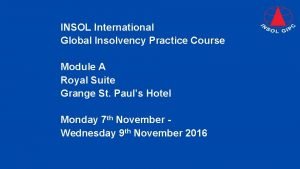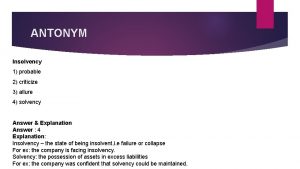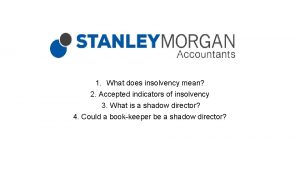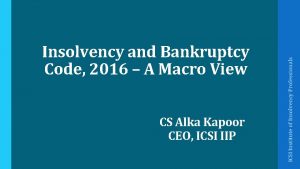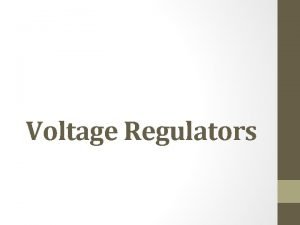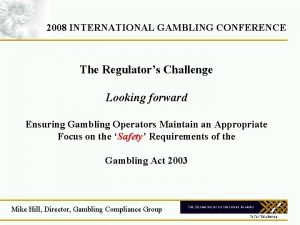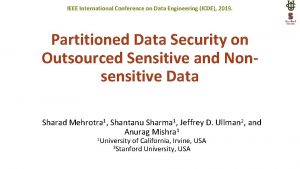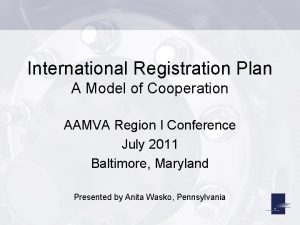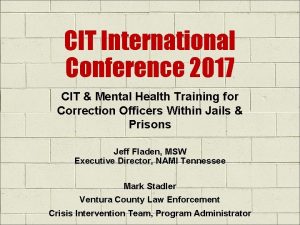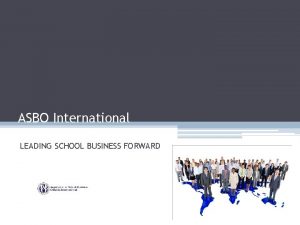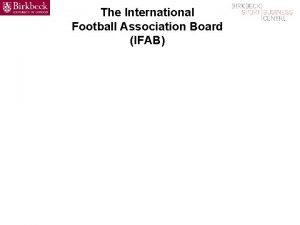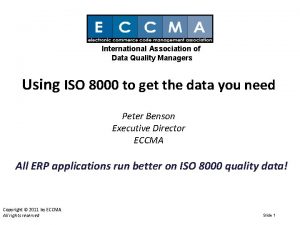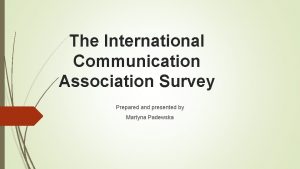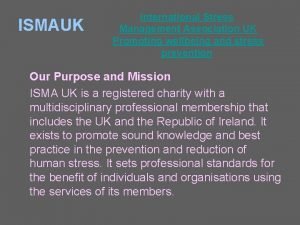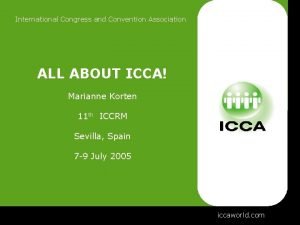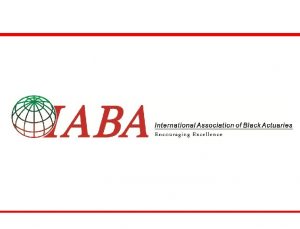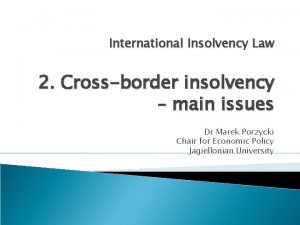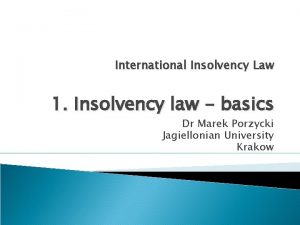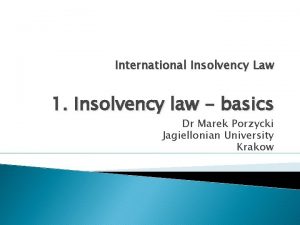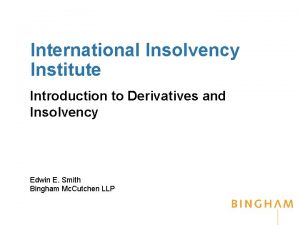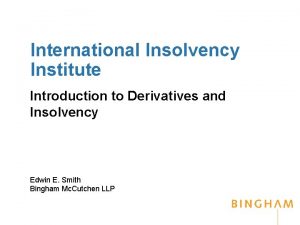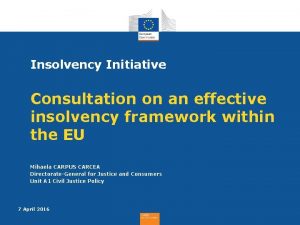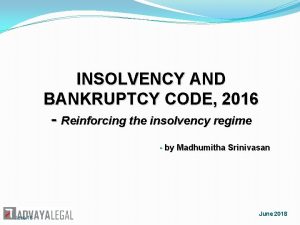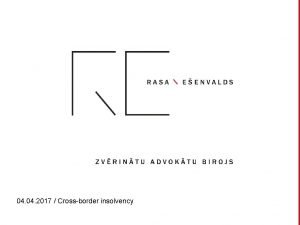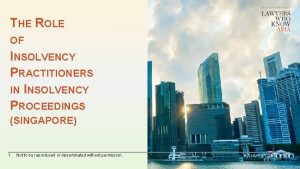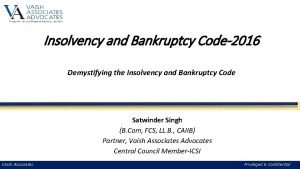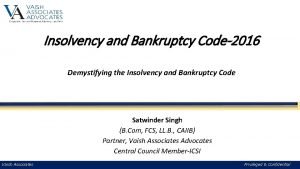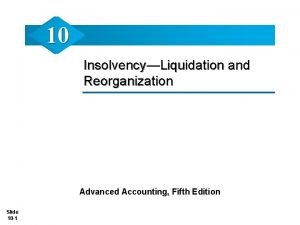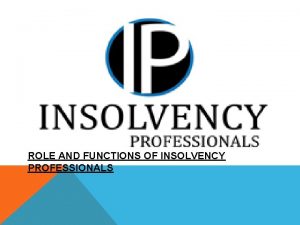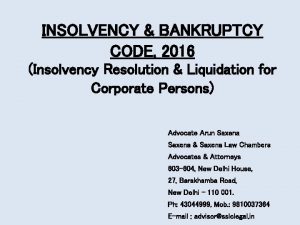IAIR International Association of Insolvency Regulators International Conference








































- Slides: 40

IAIR International Association of Insolvency Regulators International Conference on Creditors’/Debtors’ Rights and Remedies The Sukosol Bangkok, Thailand Trustees in Bankruptcy : Private Practitioners Rosemary Winter-Scott OBE IAIR Executive Director August 2018

Plenary Session 1 Trustees in Bankruptcy: Concepts and Principles of Assigning the Power of Controlling the Estate to Private Professionals from the International Perspective, Its Trends and Challenges My understanding = How is it set up So I will be looking at models of private sector involvement the benefits & challenges

Plenary Session 2 Trustees in Bankruptcy: Private Practitioners – Public Regulator, the best practices and factors to success My understanding = How is it regulated So I will be looking at the principles of regulation of Insolvency Practitioners

Content – Plenary Session 1 • Private Sector Trustees – examples – benefits – disadvantages • Compromise Solution (Public private partnership) – benefits – requirements • Case Study Example (with thanks to colleagues in Scotland)

Private Sector Trustees • Delivered by Insolvency Practitioners (IPs)/the private sector • As a Trustee in either: – a bankruptcy case – or in an alternative product to bankruptcy • Alternative examples; Protected Trust Deeds (Scotland), Personal Insolvency Arrangements (Ireland), Debt Management Plans (UK) • N. B. IAIR has produced a report comparing some of the alternatives to bankruptcy (available on its website – in the members area) https: //www. insolvencyreg. org

Private Sector Trustees - benefits • The cost is borne by the debtor/IP and creditors – not the insolvency service – resulting in greater savings for the public purse • Greater ability to cope with fluctuations in demand (than needing to high/fire civil servants to delivery in-house) • A better fit with government’s purpose – ie the focus of civil servants being more on policy and legislation than on delivery • Prevents accusations of government competing with/taking business away from the private sector

Private Sector Trustees - disadvantages • Products are harder for the insolvency service to oversee/control the quality of delivery • The IPs focus is not always on the benefits for the debtor and creditor – more on their own business profitability • Some evidence of some IPs “selling” products to debtors that are not the best solution for the debtor or creditor • IP may get paid before creditors meaning <50% of ingathered funds go to creditors • Some (old) cases the debtor has not been discharged for a considerable period because the IP is seeking to recover their costs from the case – whereas the state would have cut its losses and discharged the debtor

Compromise solution • Public/private partnership • Government insolvency service maintains responsibility as Trustee but contracts the work out to the private sector to deliver • Private sector (individuals /organisations) “win” the work on the basis of a tender process

Compromise solution - benefits • Ability to cope with fluctuations in demand • Tendering process – enables contacts to be awarded on the basis of quality and cost • Can deliver significant financial savings • Greater control over quality of delivery • Delegates the authority for delivery to the private sector • But retains the ultimate responsibility within the government service

Compromise solution - requirements Skills within the government service to: • Deliver a tendering process – a complicated legal process where you need to be clear what you are requiring as part of the delivery contract and able to withstand any legal challenge from unsuccessful bidders • Manage a contract – and ability to contract review the success bidders, ensuring they deliver the service as specified in any contact/manual and to required timescale/cost/quality criteria

Case Study - Scotland Scottish bankruptcy legislation: • Insolvency Practitioners (IPs) act as Trustee when: – nominated by the petitioning creditor – appointed by the debtor (applying for bankruptcy) • The Accountant in Bankruptcy (Ai. B) – (Government) acts as Trustee when no private Trustee appointed • Ai. B empowered to appoint individuals to carry out work on its behalf – IP’s - selected through a competitive tendering process – Contract awarded on the basis of: cost, quality, technical awareness & sustainability – Dedicated contract management team – monitor suppliers, scrutinise management information & review performance

Scotland – Case Management 2017/18 - Ai. B – Trustee in 83% of all bankruptcy cases • All Minimal Asset Process (MAP) cases (with significantly reduced administration) managed by in-house team (1880 in 2017/18) • A small proportion of full administration cases are handled by in-house team • Majority of full administration cases - allocated to contracted IPs currently ≥ 4, 500 cases being managed through the contract • Two suppliers appointed in 2017 (3 rd contract allocation) • Cases are managed through to their conclusion • Contract duration - 2 years with two optional 1 year extensions

Scotland – Insolvency Contract No guarantee of volume – awarded a percentage of cases IPs are paid: • A fixed fee to manage case: – 65% for specific duties – 35% when case administration is concluded • Commission payments to realise assets & secure debtor contributions Commissions Fee due from Contributions received 25% Fee due from other Assets recovered (Heritable, Moveable, Other) - Net of Secured Creditor expenses Fee Due on PPI collected, in addition to the Asset fee above - (internal process only and no third party agent has acted) 15% of the first £ 50, 000 5% from £ 50, 001 -£ 100, 000 2% thereafter Fee Due on Dividends Paid 15% 10% of the first £ 10, 000 5% from £ 10, 001 -£ 20, 000 1% thereafter

Scotland – Insolvency Contract The success of the contract has allowed: • a higher proportion of costs to be recovered • helped Ai. B move toward full cost recovery N. B. increase in gross costs from 2015/16 due to a new method for accounting for case-related legal expenses

Scotland – Insolvency Contract The success of the contract has allowed: • a higher proportion of costs to be recovered • helped Ai. B move toward full cost recovery

Scotland – Insolvency Contract Volumes have fallen considerably in recent years • fewer cases have been allocated to providers. But performance has remained strong 2015/16

Scotland – Insolvency Contract - Conclusion The allocation of work to external suppliers provides: • expertise • improved levels of flexibility • allows for peaks and troughs in demand levels to be managed more efficiently • value for money to the public purse In 2017/18 the average cost of administering a bankruptcy where Ai. B is the trustee, for the full life of the case, was £ 386

IAIR International Association of Insolvency Regulators International Conference on Creditors’/Debtors’ Rights and Remedies The Sukosol Bangkok, Thailand Trustees in Bankruptcy : Private Practitioners Rosemary Winter-Scott OBE IAIR Executive Director August 2018

Plenary Session 2 Trustees in Bankruptcy: Private Practitioners – Public Regulator, the best practices and factors to success My understanding = How is it regulated So I will be looking at the principles of regulation of Insolvency Practitioners

Content – Plenary Session 2 Regulation of Insolvency Practitioners • IAIR Members Survey - initial findings presented at the 2016 IAIR conference - information from slides by Richard Dennis (Scotland) & Dean Beale (England & Wales) • Development of Principles of Regulation of Insolvency Practitioners from the members survey information - Project undertaken by Prof Riz Mokal - Initial research project outlined at 2017 conference - Report will be launched at the 2018 IAIR conference

IAIR Member’s Survey 2016 21 responses from 19 Countries - (87%) of all members

IAIR Member’s Survey 2016 Scope of Questionnaire - Key topics included: • Insolvency regime overview • Qualifications and licensing • Appointment of insolvency practitioners • Standards and ethics • Disciplinary regimes • Practitioner fees • The future - Regulatory Challenges - Forthcoming Reforms

IAIR Member’s Survey 2016 The arrangements are not all the same in all countries…. “Insolvency Practice is not regulated in Bermuda” (Country Report 2016)

IAIR Member’s Survey 2016 But it was not about what is right or wrong:

Insolvency Regimes – Key Themes • Universally structured approach • Government and private appointments • Government office holder default appointment • Clear legislation in place to govern insolvency practitioners • Oversight/direction of the court • Predominantly Government bodies or licenced organisations

Qualifications and Licensing – Key Themes • Qualifications set out in legislation • Broadly, no requirement for speciality qualification in insolvency • No distinct approach to licensing • Licenses usually awarded for 1 -3 years • Strong preference for insolvency practitioners/firms to have appropriate insurance or bonding

Appointment of an Insolvency Practitioner – Key Themes • Variation in appointments process for insolvency practitioners • Appointments generally made from the outset • Practitioner is generally chosen • Majority allow more than one appointment in each case • Vast majority legislate for removal of office in certain circumstances

Standards of work and ethics – Key Themes • Standards of conduct and practice generally set out in legislation • Various issues including duty, records, reporting and handling funds • No common review schedule/timing for standards guidance • Virtually all returns comply with some ethical standards • Monitoring and information processes in place throughout • Returns show monitoring arrangements across range of practitioner activity

Disciplinary regime for insolvency practitioners – Key Themes • Consensus on structured complaints system • Different views on proactively seeking out “tip-offs” • All complaints investigated – but different approaches • Similar responses for instigation of disciplinary action • Sanctions vary – reprimands, fines, removal, disqualification and compensation • General consensus on publication of sanctions

Practitioner Fees – Key Themes • Fees generally paid from realised estate • No common approach to fee calculation • Remuneration rates not usually fixed in statute • All returns include formal process to report and agree remuneration • Practitioners generally get no fees where insufficient assets realised • Fee disputes resolved through courts • No agreed approach on repaying excessive fees to the estate

UK Fundamental Principles An Insolvency Practitioner is required to comply with the following fundamental principles: (a) Integrity (b) Objectivity (c) Professional Competence and Due Care (d) Confidentiality; and (e) Professional Behaviour

The Future – Key Challenges • Monitoring insolvency practitioners, conduct, impartiality and compliance with legislation/codes • Exercising controls over incurred costs • Encouraging creditor engagement • Reducing regulatory burden • Conflicts – small population/low numbers of practitioners • Cross-border complexity

The Future – Key Reforms Greater balance between creditors and debtors More proactive approach to regulation and sanction Timely administration and return to creditors Transparency Improving competitiveness/reducing cost of administration • Transparent communications • • •

IAIR Principles The Regulatory Regime for Insolvency Practitioners – “The IAIR Principles” Developed by Dr Riz Mokal, South Square, University of Florence, UCL

December 2013 Vienna While support was expressed in favour of the proposal [regarding IP regulatory principles], the Working Group was of the view that work might best be developed informally in cooperation with relevant professional bodies such as the International Association of Insolvency Regulators (IAIR) with a view to possible consideration by the Working Group at a later date.

Methodology – used by Prof Riz Mokal 1. Identify key issues from the IAIR Survey 2. Juxtapose against comparable standards (e. g. EBRD Office Holder Principles) to identify gaps and inconsistencies 3. Tabulate IAIR members’ extant approaches 4. Formulate Draft Principles, avoiding excessive: a) Restrictiveness – ruling out valid approaches b) Vagueness – uninformative, failing to provide normative guidance 5. Include Principles and Commentary 6. Multiple rounds of IAIR feedback

Draft IAIR Regulatory Principles - Second iteration • • • Scope of Principles Scope of Authorisation Status of Regulatory Regime Court Powers Regulatory Bodies Qualification and Authorisation IP Appointment and Removal Professional Ethical Standards Supervision and Accountability Remuneration

Approaches • State vs Self Regulation -Key divide amongst IAIR member systems • Not an ‘either / or’ choice - Profession’s autonomy in rule-making - Who monitors compliance? - Accountability mechanisms - Whether rules legally enforceable

Approaches –Self-Regulation Benefits Costs Greater regulator/regulated trust Less open to external scrutiny Market expertise Lax standards innovation Lower monitoring intensity Lower compliance costs Less likely to find breaches Profession internalises costs Lower sanctions levels

IAIR Principles - Principles of Regulation • Final version to be launched on 16 th October 2018 • At the IAIR conference in Mauritius
 Association of independent insolvency practitioners
Association of independent insolvency practitioners North american gaming regulators association
North american gaming regulators association Global insolvency practice course
Global insolvency practice course Adriaanse turnaround management and bankruptcy download
Adriaanse turnaround management and bankruptcy download Allure antonym
Allure antonym Dikesh bulsara
Dikesh bulsara Iipicsi
Iipicsi Gmail
Gmail Brushy bill
Brushy bill Ac regulators in power electronics
Ac regulators in power electronics Regulators gestures
Regulators gestures Shunt voltage regulator
Shunt voltage regulator Insulin
Insulin Oak schuetz
Oak schuetz Travel health insurance association annual conference
Travel health insurance association annual conference Doca defense
Doca defense International cryogenic engineering conference
International cryogenic engineering conference International gambling conference
International gambling conference Fassi kafyeke
Fassi kafyeke Ieee international conference on data engineering
Ieee international conference on data engineering Parvuli dei banner examples
Parvuli dei banner examples International space development conference
International space development conference International telemetry conference
International telemetry conference Aamva international conference
Aamva international conference Cometva
Cometva Cit international conference
Cit international conference Asbo international conference
Asbo international conference International football association board (ifab)
International football association board (ifab) International cpted association
International cpted association Www.seedtest.org
Www.seedtest.org International hotel and restaurant association
International hotel and restaurant association International association for information and data quality
International association for information and data quality Certified clinical trauma professional
Certified clinical trauma professional International communication association
International communication association Lions club new member orientation
Lions club new member orientation International slurry seal association
International slurry seal association International association of astronomical artists
International association of astronomical artists International stress management association
International stress management association International association for water law
International association for water law International congress and convention association
International congress and convention association International association of black actuaries
International association of black actuaries



